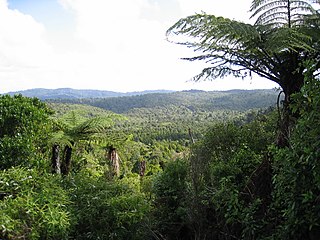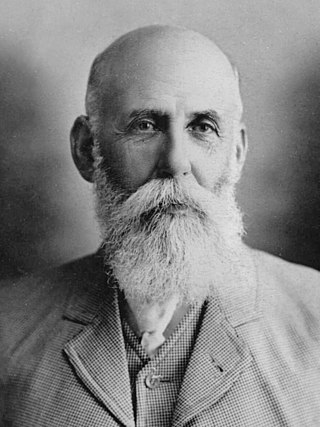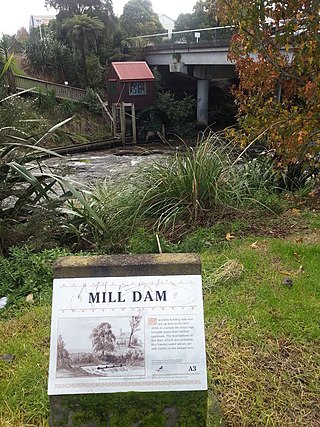
Veronica sect. Hebe is a group of plants within the genus Veronica, native to New Zealand, Rapa in French Polynesia, the Falkland Islands and South America. It was formerly treated as the separate genus Hebe. It includes about 90 species. Almost all species occur in New Zealand, apart from Veronica rapensis and Veronica salicifolia, found in South America. It is named after the Greek goddess of youth, Hebe. Informally, species in the section may be called shrubby veronicas or hebes.

Auckland is one of the 16 regions of New Zealand, which takes its name from the eponymous urban area. The region encompasses the Auckland metropolitan area, smaller towns, rural areas, and the islands of the Hauraki Gulf. Containing 33 percent of the nation's residents, it has by far the largest population and economy of any region of New Zealand, but the second-smallest land area.

The Waitākere Ranges is a mountain range in New Zealand. Located in West Auckland between metropolitan Auckland and the Tasman Sea, the ranges and its foothills and coasts comprise some 27,720 hectares of public and private land. The area, traditionally known to Māori as Te Wao Nui o Tiriwa, is of local, regional, and national significance. The Waitākere Ranges includes a chain of hills in the Auckland Region, generally running approximately 25 kilometres (16 mi) from north to south, 25 km west of central Auckland. The ranges are part of the Waitākere Ranges Regional Park.

Whatipu is a remote beach on the west coast of the Auckland Region in the North Island of New Zealand. The Whatipu area has been managed as a scientific reserve by the Auckland Regional Council since 2002. The road to it is unsealed. To the south of Whatipu is Manukau Harbour. To the north is Karekare. Whatipu is located at the southern end of the Waitākere Ranges. Shifting sands have substantially changed the beach since the 1940s. Over 6 square kilometres has been added to the beach since then.

Veronica is the largest genus in the flowering plant family Plantaginaceae, with about 500 species. It was formerly classified in the family Scrophulariaceae. Common names include speedwell, bird's eye, and gypsyweed.

Thomas Frederick Cheeseman was a New Zealand botanist. He was also a naturalist who had wide-ranging interests, such that he even described a few species of sea slugs.

Oratia is a semi-rural locality on the western edge of metropolitan West Auckland in New Zealand.

Lake Kawaupaka, also known as Lake Kawaupaku, is a small lake near Te Henga in the Auckland Region of New Zealand. The lake is on private land, and is one of the few dune lakes in the region to be surrounded by native forest. It is located south-west of Lake Wainamu.

Lucy May Cranwell was a New Zealand botanist responsible for groundbreaking work in palynology. Cranwell was appointed curator of botany at Auckland Museum in 1929, when she was 21 years old. As well as her work on ancient pollen samples she was responsible for encouraging a love of botany in a generation of Auckland children.

Veronica odora, known as the boxwood hebe, mountain-box, Hebe odora or Hebe buxifolia, is a plant in the family Plantaginaceae, and it is native to New Zealand. Veronica odora was discovered on the Auckland Islands by J.D Hooker in 1840. A certain amount of confusion later arose following its collection on mainland New Zealand by Ernst Dieffenbach and its naming as Veronica buxifolia by George Bentham. Even overseas, Veronica odora is still not infrequently known as Veronica buxifolia.

Veronica salicifolia, synonym Hebe salicifolia, the koromiko, or willow-leaf hebe, is a flowering plant in the family Plantaginaceae, which is found throughout the South Island of New Zealand and in Chile. It is a large, evergreen shrub, reaching 2 m in height, with light-green, spear-shaped leaves that are up to 12 cm long, and white or pale lilac flowers.

Veronica jovellanoides, commonly known as Riverhead speedwell, is a threatened flowering plant in the family Plantaginaceae. It is endemic to New Zealand, where only three plants are known in the wild. All are found within the Ernest Morgan Reserve, a 20 ha forest northwest of Auckland. Its discovery is accredited to a retired plant nursery owner, Geoff Davidson, who organised the land's protection a few decades prior, and found it by chance on a walk in November 2007.

Pomaderris rugosa, wrinkle-leaved kūmaraho, or wrinkle-leaf pomaderris, is endemic to lowlands of the upper North Island of New Zealand. It is a widely spreading, much-branched shrub, with reddish hairy branches and narrow wrinkled narrow leaves, up to 6 cm (2.4 in) long and up to 1.4 cm (0.55 in) wide, which are dark green on top and pale-grey below. P. rugosa grows up to 3 m (9.8 ft), or sometimes 12 m (39 ft) and flowers mainly from October to December, with cream to yellow blossom, formed of many small clusters. Fruit is dry and small and present from November to May. P. rugosa is frost resistant.

West Auckland is one of the major geographical areas of Auckland, the largest city in New Zealand. Much of the area is dominated by the Waitākere Ranges, the eastern slopes of the Miocene era Waitākere volcano which was upraised from the ocean floor, and now one of the largest regional parks in New Zealand. The metropolitan area of West Auckland developed between the Waitākere Ranges to the west and the upper reaches of the Waitematā Harbour to the east. It covers areas such as Glen Eden, Henderson, Massey and New Lynn.

The Ōpanuku Stream, formerly known as the Henderson Stream, is a stream of the Auckland Region of New Zealand's North Island. It flows east from its source the Waitākere Ranges through the Henderson Valley, then north-east through West Auckland before entering into the Te Wai-o-Pareira / Henderson Creek, which flows into the western the Waitematā Harbour. The stream passes through the rural locality of Henderson Valley and the West Auckland suburbs of Western Heights and Henderson. Since the mid-2000s it has been forested with native flora.

Veronica bishopiana, the Waitākere rock koromiko, is a flowering plant belonging to the family Plantaginaceae. It is native to West Auckland in New Zealand, and was first described by Donald Petrie in 1926.

Myosotis laeta is a species of flowering plant in the family Boraginaceae, endemic to ultramafic areas of the Sounds-Nelson area of the South Island of New Zealand. Thomas Cheeseman described the species in 1885. Plants of this species of forget-me-not are perennial rosettes which form loose tufts or clumps, with ebracteate, erect inflorescences, and white corollas.

Te Rau-o-te-Huia / Mount Donald McLean is a hill in the Waitākere Ranges of the Auckland Region of New Zealand's North Island. It is located to the south of the ranges, near the township of Huia. It is the highest peak of the Waitākere Ranges that borders the Manukau Harbour.

Lepidium amissum, also known as Waitakere scurvy grass, is an extinct species of plant in the family Brassicaceae. The plant was first described by Peter de Lange and Peter Brian Heenan in 2013, and was formerly endemic to the sea cliffs of the Waitākere Ranges of West Auckland, New Zealand.

The Auckland Region of New Zealand is home to numerous endemic flora and fauna. Many of these species have ranges restricted to the Waitākere Ranges, Great Barrier Island, Little Barrier Island and the Mokohinau Islands. A number of species have restricted ranges that include areas outside of the Auckland Region, such as Buller's shearwater and Pycroft's petrel, or organisms such as the brown teal / pateke and stitchbird / hihi which have recently increased ranges due to conservation efforts.




















